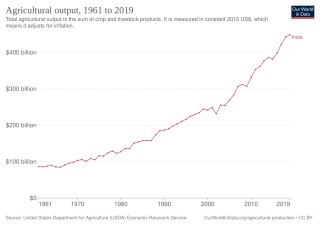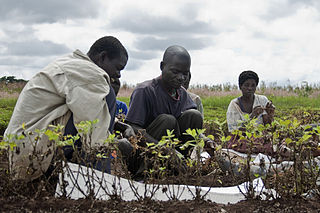Related Research Articles

The economy of Guatemala is a considered a developing economy, highly dependent on agriculture, particularly on traditional crops such as coffee, sugar, and bananas. Guatemala's GDP per capita is roughly one-third of Brazil's. The Guatemalan economy is the largest in Central America. It grew 3.3 percent on average from 2015 to 2018. However, Guatemala remains one of the poorest countries in Latin America and the Caribbean, having highly unequal incomes and chronically malnourished children. The country is beset by political insecurity, and lacks skilled workers and infrastructure. It depends on remittances for nearly one-tenth of the GDP.

Agricultural policy describes a set of laws relating to domestic agriculture and imports of foreign agricultural products. Governments usually implement agricultural policies with the goal of achieving a specific outcome in the domestic agricultural product markets.

An agricultural subsidy is a government incentive paid to agribusinesses, agricultural organizations and farms to supplement their income, manage the supply of agricultural commodities, and influence the cost and supply of such commodities.
Feminization of poverty refers to a trend of increasing inequality in living standards between men and women due to the widening gender gap in poverty. This phenomenon largely links to how women and children are disproportionately represented within the lower socioeconomic status community in comparison to men within the same socioeconomic status. Causes of the feminization of poverty include the structure of family and household, employment, sexual violence, education, climate change, femonomics and health. The traditional stereotypes of women remain embedded in many cultures restricting income opportunities and community involvement for many women. Matched with a low foundation income, this can manifest to a cycle of poverty and thus an inter-generational issue.

Poverty reduction, poverty relief, or poverty alleviation is a set of measures, both economic and humanitarian, that are intended to permanently lift people out of poverty.

A smallholding or smallholder is a small farm operating under a small-scale agriculture model. Definitions vary widely for what constitutes a smallholder or small-scale farm, including factors such as size, food production technique or technology, involvement of family in labor and economic impact. Smallholdings are usually farms supporting a single family with a mixture of cash crops and subsistence farming. As a country becomes more affluent, smallholdings may not be self-sufficient, but may be valued for the rural lifestyle. As the sustainable food and local food movements grow in affluent countries, some of these smallholdings are gaining increased economic viability. There are an estimated 500 million smallholder farms in developing countries of the world alone, supporting almost two billion people.

The history of agriculture in India dates back to the Neolithic period. India ranks second worldwide in farm outputs. As per the Indian economic survey 2020 -21, agriculture employed more than 50% of the Indian workforce and contributed 20.2% to the country's GDP.

The main economic products of Malawi are tobacco, tea, cotton, groundnuts, sugar and coffee. These have been among the main cash crops for the last century, but tobacco has become increasingly predominant in the last quarter-century, with a production in 2011 of 175,000 tonnes. Over the last century, tea and groundnuts have increased in relative importance while cotton has decreased. The main food crops are maize, cassava, sweet potatoes, sorghum, bananas, rice, and Irish potatoes and cattle, sheep and goats are raised. The main industries deal with agricultural processing of tobacco, tea and sugar and timber products. The industrial production growth rate is estimated at 10% (2009).

Agriculture in the Philippines is an important sector in the economy with crops like bananas, coconuts, pineapples, rice and sugarcanes are being mass-produced for exportation but the challenge remains as it steadily running into deficit amid growing population. As of 2022, the sector employs 24% of the Filipino workforce and it accounted for 8.9% of the total GDP.

Angola is a potentially rich agricultural country, with fertile soils, a favourable climate, and about 57.4 million ha of agricultural land, including more than 5.0 million ha of arable land. Before independence from Portugal in 1975, Angola had a flourishing tradition of family-based farming and was self-sufficient in all major food crops except wheat. The country exported coffee and maize, as well as crops such as sisal, bananas, tobacco and cassava. By the 1990s Angola produced less than 1% the volume of coffee it had produced in the early 1970s, while production of cotton, tobacco and sugar cane had ceased almost entirely. Poor global market prices and lack of investment have severely limited the sector since independence.
Gender roles in agriculture are a frequent subject of study by sociologists and farm economists. Historians also study them, as they are important in understanding the social structure of agrarian, and even industrial, societies. Agriculture provides many job opportunities and livelihoods around the world. It can also reflect gender inequality and uneven distribution of resources and privileges among gender.

Rural poverty refers to situations where people living in non-urban regions are in a state or condition of lacking the financial resources and essentials for living. It takes account of factors of rural society, rural economy, and political systems that give rise to the marginalization and economic disadvantage found there. Rural areas, because of their small, spread-out populations, typically have less well maintained infrastructure and a harder time accessing markets, which tend to be concentrated in population centers.
In the agricultural context, diversification can be regarded as the re-allocation of some of a farm's productive resources, such as land, capital, farm equipment and labour to other products and, particularly in richer countries, to non-farming activities such as restaurants and shops. Factors leading to decisions to diversify are many, but include: reducing risk, responding to changing consumer demands or changing government policy, responding to external shocks and, more recently, as a consequence of climate change.
Women's property rights are property and inheritance rights enjoyed by women as a category within a society.
The agricultural system in Sub-Saharan Africa is a predominantly small-scale farming system with more than 50% of the agricultural activity performed by women, producing about 60-70% of the food in this region. While women provide the majority of the labor in agricultural production, their access and control over productive resources is greatly constrained due to inequalities constructed by patriarchal norms.

Gender inequality both leads to and is a result of food insecurity. According to estimates, women and girls make up 60% of the world's chronically hungry and little progress has been made in ensuring the equal right to food for women enshrined in the Convention on the Elimination of All Forms of Discrimination Against Women. Women face discrimination both in education and employment opportunities and within the household, where their bargaining power is lower. On the other hand, gender equality is described as instrumental to ending malnutrition and hunger. Women tend to be responsible for food preparation and childcare within the family and are more likely to be spent their income on food and their children's needs. The gendered aspects of food security are visible along the four pillars of food security: availability, access, utilization and stability, as defined by the Food and Agriculture Organization.

India has an economy bound to its historical agricultural tradition. In the North, the Indus valley and Brahmaputra region are critical agricultural areas with water supplied by the Ganges and monsoon season. Agriculture is a way of life for the majority of India's population; based on 2011 World Bank data, only 17.5% of India's gross domestic product (GDP) is accounted for by agricultural production. Women are an important but often overlooked population involved in India's agricultural production—they represent the majority of the agricultural labor force in India. Women's participation in the agrarian labor force plays out in various ways, impacting their economic independence, their decision-making abilities, their agency and access to education and health services. Many women in farming communities suffer poverty and marginalization, and issues of gender inequality.
Food sovereignty is a highly influential idea in Bolivian political discourse. It is incorporated into multiple pieces of Bolivian legislation, including the 2009 constitution drafted underneath president Evo Morales. Food sovereignty fits into Morales' larger goal of the symbolic decolonization of Bolivia. First coined by indigenous and peasant worker advocacy organization Via Campesina, food sovereignty is the right for a state's people to produce and distribute culturally appropriate foods without the impingement of economic pressures created by foreign agribusiness producers. The presence of foreign agribusiness in Bolivia can be traced back to exploitative resource extraction that proliferated in South America with 19th century liberalism. Modern-day wholesale agribusiness production makes competition difficult for Bolivia's small-scale farmers, who often take out high-interest loans and consequently accumulate debt.
Agriculture makes up a significant proportion of the Gambia's economy, comprising 25% of its GDP. About 75% of workers in the Gambia are employed within the agricultural industry. The main cash crops produced in the country are groundnuts, millet, sorghum, mangoes, corn, sesame, palm kernel, and cashews. The main staple crop produced is rice.
Rural women are a fundamental part of rural communities around the world. The play an important part of the rural society, both providing care work and being involved in number of economic pursuits such as subsistence farming, petty trading and of- the-farm works. In most parts of the world, rural women work very hard but earn very little.
References
- 1 2 3 "Gender | Food and Agriculture Organization of the United Nations". www.fao.org.
- 1 2 Deere, 2009 p. 99
- ↑ Robinson-Pant, Anna (2016). Learning knowledge and skills for agriculture to improve rural livelihoods (PDF). UNESCO. p. 30. ISBN 978-92-3-100169-7.
- ↑ World Bank, FAO & IFAD. 2009. Gender in agriculture sourcebook. Washington, DC. World Bank.
- 1 2 "WomenWatch: Women, Gender Equality and Climate Change". www.un.org.
- 1 2 Whitehead, 2009 p.45
- 1 2 ActionAid 2010
- ↑ Reardon and Vosti 1995
- ↑ Whitehead, 2009 p.43
- ↑ Boserup, 1970
- ↑ Whitehead, 2009 p. 50
- ↑ Razavi, 2009 p.4
- 1 2 Whitehead, 2009 p.39
- ↑ Deere, 2009 p. 121
- ↑ Whitehead, 2009 p.46
- ↑ Deere 2009, p. 107
- ↑ Whitehead 2009, p. 51
- ↑ Deere 2009, 108
- ↑ Food and Agriculture Organization (1995) “Women, agriculture and rural development: a synthesis report of the Africa region”. http://www.fao.org/docrep/X0250E/X0250E00.htm
- ↑ ActionAid (2010). Womens rights and access to land http://www.actionaid.it/filemanager/cms_actionaid/images/DOWNLOAD/Rapporti_DONNE_pdf/HerMile_AAItaly.pdf
- ↑ Cornheil 2008 http://www-wds.worldbank.org/external/default/WDSContentServer/WDSP/IB/2007/11/08/000310607_20071108143621/Rendered/PDF/41367optmzd0Fe1Agriculture01PUBLIC1.pdf
Sources
- Boserup, Ester (1970.) PP 15–65 Woman's Role in Economic Development. Male and female farming systems. London: Earthscan.
- Deere, Carmen Diana (2009.) PP 99–127 The Gendered Impacts of Liberalization. The Feminization of Agriculture?: The Impact of Economic Restructuring in Rural Latin America. United Nations Institute for Social Development.
- Razavi, Shahra (2009.) PP 1–34 The Gendered Impacts of Liberalization. The Gendered Impacts of Liberalization: Towards "Embedded Liberalism?". United Nations Institute for Social Development.
- Reardon, T. and S.A. Vosti (1995). “Links between rural poverty and the environment in developing countries: Asset categories and investment poverty.” World Development, Vol. 23(9) pp 1495–1506.
- Whitehead, Ann (2009.) PP 37–62 The Gendered Impacts of Liberalization. The Gendered Impacts of Liberalization Policies on African Agricultural Economies and Rural Livelihoods. United Nations Institute for Social Development.